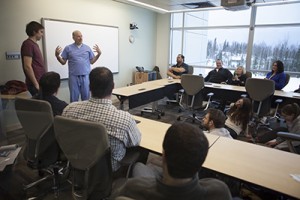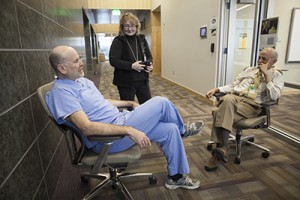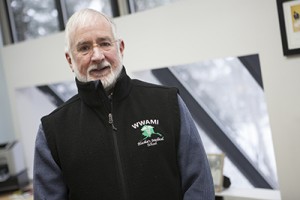Nurturing a network of doctors
by Tracy Kalytiak |
A surgeon clad in pale-blue scrubs stood at the front of a glass-walled classroom, palpating an area on the shoulder of a young man in a T-shirt and jeans.

Dr. Steve Tower, an Anchorage orthopedic surgeon, demonstrates shoulder exam techniques
with first-year WWAMI student Tom Steck, left, for an audience that includes other
WWAMI students.
Photo by Philip Hall/University of Alaska Anchorage
"You've got to feel through the anterior attachment of the deltoid there," said the man in scrubs, Dr. Steve Tower, an Anchorage orthopedic surgeon. "The coracoid is the lighthouse of the shoulder; it's a very good landmark for doing injections."
Men and women sat on the floor and on chairs around a horseshoe of tables at UAA's Health Sciences Building. All of them intently scanned Tower's every move. Some of those watching that shoulder-exam demonstration were among 20 students enrolled in the Alaska WWAMI School of Medical Education-Alaska's arm of the University of Washington School of Medicine.
Tower, himself a WWAMI graduate, is one of nearly 200 Alaska physicians who play a critical role in the medical education of WWAMI students receiving training here.
The network of instructors and physicians who train Alaska's WWAMI students is long standing, but Premera Blue Cross Blue Shield of Alaska recently donated $100,000 to WWAMI's effort to tighten that network into a more coalesced faculty.
"For the first time, we'll be able to provide coordinated training and resources to make it easier for physicians to take our students into their practices and teach them," said Dr. Nancy Jane Shelby, Alaska WWAMI's academic director. Dr. Thomas S. Nighswander serves as WWAMI's clinical director.
Giving real-world experience
WWAMI needs help from more community physicians willing to give students a chance to work and learn in real-world clinics and hospitals. The donation will fund training workshops targeting community physicians-providing ways to update their skills and bringing them together not only with students but also with Alaska physicians who teach either as first-year preceptors, clerkship directors or residency faculty.

Dr. Steve Tower, left, Dr. Jane Shelby and Dr. Tom Nighswander talk at UAA's Health
Sciences Building. Tower is a former WWAMI student; Shelby and Nighswander are the
directors of Alaska WWAMI.
Photo by Philip Hall/University of Alaska Anchorage
"Developing the faculty will benefit not only the WWAMI program, but the future of health care in Alaska," said William H. Hogan, dean of UAA's College of Health.
WWAMI teaching sites are located throughout Alaska. Communities that offer opportunities to WWAMI students include Anchorage, Wasilla, Homer, Seward, Kodiak, Prince of Wales Island, Sitka, Metlakatla, Ketchikan, Petersburg, Juneau, Haines, Cordova, Valdez, Delta Junction, Fairbanks, Galena, Kotzebue, Nome, Bethel, Dillingham, Unalaska and Soldotna.
WWAMI's 20 Alaska-based students currently spend their first year training at UAA, travel to Seattle for their second year and then return to Alaska or elsewhere in the WWAMI region for clinical rotations in their third and fourth years. In 2015, WWAMI will launch a new "Foundations Phase" curriculum, which will enable students to complete their first and second years of medical school at UAA.
Alaska needs more doctors
The organization then known as WAMI (pronounced "whammy") was founded in 1971. The first letters of the names of states it served-Washington, Alaska, Montana and Idaho-formed an acronym, WAMI. The addition of Wyoming in 1997 added the second "W" to WWAMI's name.
WWAMI's original goals were to provide public medical education to people living in states with a population too small to afford the cost of establishing a medical school, and train physicians to practice in states that historically had a difficult time attracting an adequate number of doctors.

William Hogan, dean of the UAA College of Health, wears a sought-after WWAMI vest.
Photo by Philip Hall/University of Alaska Anchorage
WWAMI's effort is vital because Alaska needs more physicians, particularly those that specialize in primary care and psychiatry.
The state has only 2.05 physicians per 1,000 population compared to the national average of 2.38 physicians per 1,000 people, due in part to Alaska's rural nature, severe weather and great distances-1,400 miles, north to south, and 2,400 miles, east to west.
Opening possibilities
Nearly three-quarters of WWAMI students training in Alaska go on to practice as doctors in Alaska.
It's possible that Tom Steck, a first-year WWAMI student, might turn out to be one of them. Steck is the person whose shoulder Tower was probing during that exam demonstration.
"As a doctor, you kind of learn to do things to other people," said Steck, 24, of Anchorage. "I liked learning the exam that way. I could feel the pressure he was putting on the joints, where his fingers were digging to palpate anatomic features of the shoulder. He obviously had a great field of knowledge to show us."
Steck had volunteered in medical endeavors in the Dominican Republic and U.S. before deciding to go to medical school. He chose the WWAMI program because of its affiliation with the University of Washington's highly ranked medical school and because he is from Anchorage.
"When I tell people here I'm a med student, they say, 'Huh, I didn't know there was a med school up there,'" he said.
Steck said it's not unheard of to have three or four M.D.s at a time instructing Alaska WWAMI's class of 20 students.
"It really helps build confidence and refine those fine little skills-how to hold an ophthalmoscope, the first things you do in a physical exam," he said. "What else is neat is [WWAMI instructors] come from different backgrounds. Specialists like Dr. Tower give us a clinical flavor. He's been doing this for 30 years and knows what he's doing. We have to learn the sciences, but it's nice to get the opinion of experts, what we're likely to see in front of us as doctors."
The first WWAMI Faculty Development Workshop will be held March 7-9 in conjunction with the Alaska Academy of Family Physicians' annual Winter Update at the Hotel Alyeska. Guest speakers are Dr. Heidi Coombs and Dr. Jesse Markman, from the University of Washington School of Medicine. A panel of Alaska "Master Teachers"-physicians who, for decades, have taught WWAMI medical students and residents-will also take part in the workshop. Also, the annual Alaska PreMed Summit is scheduled for 9 a.m., March 22, at UAA's Rasmuson Hall. The summit provides information on how to become a physician, in a session designed for high school and undergraduate students, as well as counselors and parents. For more information, call the Alaska WWAMI office at (907) 786-4789.
Written by Tracy Kalytiak, UAA Office of University Advancement.
 "Nurturing a network of doctors" is licensed under a Creative Commons Attribution-NonCommercial 4.0 International License.
"Nurturing a network of doctors" is licensed under a Creative Commons Attribution-NonCommercial 4.0 International License.














